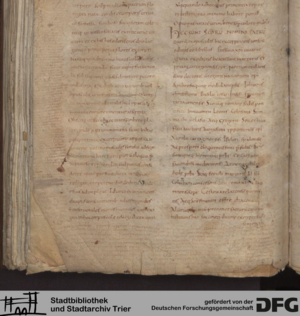Trier, Stadtbibliothek, 1084/115
| Library | Stadtbibliothek |
|---|---|
| Shelfmark | MS Hs. 1084/115 |
| Century | saec. XI |
| Provenance | ? |
| General region of origin | unknown? Possibly Trier |
| Collection | Quadripartitus |
| Author | Bruno Schalekamp |
Trier, Stadtbibliothek, MS Hs. 1084/115 is an eleventh-century manuscript of 129 folios in 1 col. (fols. 1r-103r) and 2 cols. (fols. 103v-128r) (dimensions unknown as yet). Its codicological composition reads as follows: 16 quires, (III + 1)7 + 5 x IV47 + 7 x IV103 + 2 x IV119 + (IV + 2)129; no quire signatures, modern foliation in Arabic numerals in black ink and lead pencil. It is unknown where it was written. Its provenance is certainly from Trier and presumably partially from St. Matthias' Abbey (formerly known as St. Eucharius' Abbey) and the Basilica of St. Paulinus (based on fol. 130r: liber sancti eucharii. sanctique mathie). It was penned by various hands and in different ink qualities in late Caroline minuscule.
Contents

Manuscript Trier Hs. 1084/115 is a medium-sized eleventh-century codex and contains a notable mix of prose (Sallust), computus (Helperich of Auxerre), annals (most famous among them the Annales S. Eucharii Triverensis), and canon law (the Quadripartitus). The intersectional aspect of this manuscript - including historiography, calenderology, chronology, and law - is especially striking, as these various topics were associated. It must be noted, however, that it is highly probable the canonical collection was added at a later stage to the compendium. Furthermore, at least the work of Sallust and the canonical collection seem to have been studied at a regular pace. The marginalia on the parchment, mostly corrections (in the case of the former mentioned) and explanations or discussions (the latter) between the lines by different hands, indicate this might have been the most intensively used part of the manuscript. To an extent, the same can be said about the annals, as these were edited heavily by many later hands. Fols. 99v and 100r-v seem to be particularly of interest here, as these indicate the scribes had grander plans for the future of this codex, but were cut short for unknown reasons. Possibly, another manuscript at hand took over the role of the keeping of annals.
It must also be noted that two fragments were previously inserted in the manuscript. which have now been removed. According to Becker, these were a letter of indulgence from Archbischop Baldwin to St. Matthias in 1320 (see Kentenich) and a fragment of ‘Mass apologies’ (Meßapologien) (saec. XI). Lastly, it is striking that the manuscript was not added to Arno Borst's great collection of computus-works.
| folios | texts |
|---|---|
| Front cover and flyleaf | |
| 1r-46r | Sallust: Bellum Catilinae und Bellum lugurthinum. Modern capitals in Arabic numerals in black thin ink or lead pencil |
| 46v | Excerpt of a text with the incipit ‘Septem sunt miracula mundi’. Written by a later hand (s. XII). Followed by a remarkable statement that ‘this is the book of St. Eucharius, of the first of your men (?), the archbishop. If anyone takes it away, let him be anathema. Amen.’ Written by a different but not much later hand trained in the writing of charters |
| 47r-102r | Helperich of Auxerre: Libellus Calculatoriae, De argumentis lunae. Includes the paschal cycles from 1000 until 1234. Also includes other computistical works: |
| 85r-v | Bloodletting-lunarium |
| 86v-91v | Calendar with the Egyptian Days prognostic text at the bottom |
| 95r-98r | Annales S. Eucharii Trevirensis |
| 99v | Blank page |
| 100r-v | Start of chronicle without any entries. Reads the years 1274-1335 and seems to have been erased on the bottom of the recto side and the complete verso side. Also includes a short prognostic text (?) in a late medieval hand, as well as a sketch of the lunar cycle on the verso side |
| 101r | Drawing of the lunar cycle |
| 102v | Text on the calculation of the leap year. Followed by the same statement as observed on fol. 46v (see above), also by a charter-trained hand |
| 103r | Various ‘titles’ of this codex written by different hands. Includes the codex’s provenance (see above) and earlier title: Liber de uita sacerdotum |
| 103v-128r | Collectio canonum Quadripartita (Quadripartitus), books 1-3 |
| 103vab-104ra | Preface, including dedicatory letter and list of authorities |
| 104ra-108vb | Book 1, including list of titles |
| 108vb-119rb | Book 2, including preface and list of titles |
| 119rb-128rb | Book 3, chapters 1-10, including preface and list of titles |
| 128v | The same statement as observed on fols. 46v and 102v is included, also in a charter-trained hand. Liber is here substituted for Codex. The rest of the page is blank |
| 129r-v | Insertion of unknown texts in two columns, conveniently interlaced from a smaller folio |
| Flyfleaf and back cover |
Literature
Becker, Die Benediktinerabtei St. Eucharius (1970), p. 111; Hoffmann, Buchkunst (1986), p. 491; Kerff, Quadripartitus (1982), p. 25-27; Kéry, Canonical Collections (1999), p. 168; Kentenich, Beschreibendes Verzeichnis Vol. 10 (1931), p. 11-13; Maassen, Geschichte (1870), p. 852; Martène-Durand, Amplissima collectio Vol. 1 (1724), p. 70-76; Montebaur, Studien zur Geschichte (1931), p. 101; Mordek, Kirchenrecht (1975), p. 172; Pertz, ‘Handschriftenverzeichnisse’ (1843), p. 599.
See also Michael Elliot's extensive work and draft editions of the Quadripartitus on his own website: http://individual.utoronto.ca/michaelelliot/.
Categories
- Manuscript
- digitized
- saec XI
